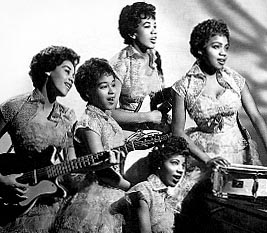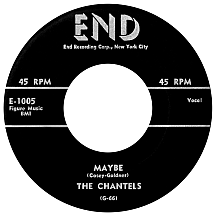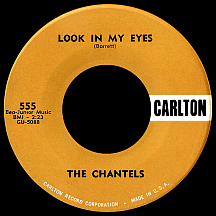THE CHANTELS
Five close friends, barely in their teens, were learning the ins and outs of choir singing at the St. Anthony of Padua school in the Bronx...with ulterior motives. A couple of girl groups had made it onto the radio and into the record stores, not older singers like the various sister acts (Andrews, Fontane, McGuire, De Castro) but teenagers just like themselves. Shirley Gunter and the Queens, from Los Angeles, set a precedent in late '54 with "Oop Shoop," then inspiration came from much closer to home: The Hearts, also from the Bronx, had a national R&B hit, "Lonely Nights," in the spring of '55. Their exposure was limited, though, unlike the aforementioned bevy of white sister acts, but it was something to shoot for. As it turned out, these St. Anthony schoolgirls had one among their ranks so immersed in a love of music, while possessing an exceptional singing voice beyond her years, that her presence alone made people take notice. Arlene Smith couldn't have guessed she would be the inspiration for many of the best youth-oriented girl groups of the following decade.
Arlene had been studying classical piano for several years, an interest she would pursue further as an adult. Six or seven of her choir partners were impatient to start a singing group, figuring if the Hearts could do it, they could too. By 1956 the dust settled and a quintet remained: soprano Lois Harris, second soprano Sonia Goring, alto Rene Minus, second alto Jackie Landry and lead singer Smith. Their name, The Chantels, was taken from another Catholic school in the Bronx, St. Frances de Chantal, whose girls' basketball team often competed against theirs (the name's similarity to the French word for singer, "chanteur," also played into the decision).
In the summer of 1957 the girls, ranging in age from 14 to 17, spontaneously audtitioned for Richard Barrett and his group The Valentines as they were leaving the Bell Sound Studio after a recording session. Barrett's career as a producer and songwriter had been going better than his efforts as a singer; he worked for George Goldner's Gone/End/Gee labels and had been involved in the production of records by a number of acts, most notably Frankie Lymon and the Teenagers. He took the Chantels to Goldner, who decided to give them a shot, met with the girls' mothers, and signed them to contracts. Another New York group, The Bobbettes, students several miles from St. Anthony's at P.S. 109, had a breakout hit at about that time with "Mr. Lee," a song the act's five members had written. Arlene had been composing her own songs and two of them, "He's Gone" and "The Plea," were recorded at Bell Sound and released on the End label (with label credit to Goldner as cowriter).
"He's Gone," with its hymnlike a cappella opening, debuted on the charts in September (while the rival Bobbettes were sitting comfortably in the top ten, rubbing elbows with the likes of Elvis, Paul Anka, The Crickets and actress-singer Debbie Reynolds). Arlene was appalled the first time she heard the song on the radio, shocked at how hard and forceful she sounded when her intent had been to perform the romantically heartbreaking lyrics in a softer tone. Her mother insisted they had redone the song with someone else, but it was Barrett's direction that had resulted in a unique vocal Arlene herself didn't realize she was capable of. Once the record hit big in New York (though it was only a minor national hit), the girls put more trust in the vision Barrett had for them.

What they learned in the school choir brought a tight structure to the group's a cappella style; one teacher had taught them the intricacies of Gregorian chants and after long practice the girls developed a fluidity of vocal style and harmony that set them apart from other teenage girl groups. Male act The Jesters took notice immediately, putting out a version of "The Plea" that hit the charts in early '58. The second Chantels single was written by Richard with input from Arlene, though Casey-Goldner was the credit shown on the label, yet another royalty-jacking move all too common during the era. The session for "Maybe" was held at a church in Manhattan that had been coverted into a recording studio; Barrett put the quintet through take after take in pursuit of perfection, though the end result is quite raw...and, as it turns out, exactly what was needed to make it a hit, top 20 on the pop charts in February and March of '58 and top five on the R&B charts. The times were indeed changing for rhythm and blues artists; the kind of mainstream pop crossover the Queens and Hearts had been unable to achieve in '54 and '55 was suddenly possible for acts like The Teen Queens (with "Eddie My Love") in '56 and the Bobbettes in '57. Now the Chantels' turn had come; their popularity even had an influence on The Shirelles when it came time for the New York-based 'Ronde-Ronde' quartet to choose a name.
More hits followed, all of them ballads, which Barrett felt best suited the style of the group. "Every Night (I Pray)" (written by Barrett) and "I Love You So" (first done by The Crows on the B side of their 1954 hit "Gee") had respectable mid-chart runs. An uptempo number at this point might have been a good idea; "Prayee" and "If You Try" rendered them hitless going into '59. "Never Let Go" had a little more tempo but drove home the concept that they were better off sticking to ballads. Lois Harris abruptly left to attend college, while Arlene, staying true to her passion for music, broke away to start a solo career.
Richard Barrett found a replacement right away in Annette Swinson of The Veneers (a girl group he had produced a single for on his own Princeton label), who began going by the name Annette Smith. Her vocal style lacked the dynamic range of her predecessor, so Chantels recordings had a different sound after that; pared to a quartet, there was less reliance on a lead singer and more focus on harmonies and unison singing. They supplied backing vocals on Barrett's solo Gone label release of "Come Softly To Me" (covering one of the year's biggest hits by The Fleetwoods), then received label credit on his next single, "Summer's Love," which hit the charts for a couple of weeks in July '59.
Two years went by before Arlene's first single appeared on Big Top with Phil Spector producing; "Love, Love, Love" slowed the tempo of The Clovers' 1956 hit, while the flip side, Carole King and Gerry Goffin's "He Knows I Love Him Too Much," became a hit in early 1962 when Spector retooled it for The Paris Sisters. Goldner had less interest in the Chantels by this time and dropped the group, giving Barrett a chance to shop around for a new label. They appeared on Carlton in the late summer of '61 with "Look in My Eyes," an ethereal ballad featuring a string arrangement. Though very different from the group's original sound, it put them back into the pop top 20 and R&B top ten.
Goldner reacted to "Look in My Eyes" in a strange way, releasing the earlier Veneers single, "I," as a Chantels disc, which was widely ignored...for the second time. The Chantels followed their big hit with "Well, I Told You," an uptempo (and thus against-formula) answer to Ray Charles' smash "Hit the Road Jack" with Barrett doing the Charles part; it was their last single to hit the top 40. After a third Carlton single, the Chantels got caught in a spiral of going from label to label without success, a pattern that lasted several years. Barrett's "Eternally," a song written by Luther Dixon and Lee Thomas and released on Dixon's Ludix label, briefly landed them on the national charts in March 1963, the same year Arlene Smith had a one-off release on End, "Mon Cherie Au Revoir," the label of the 45 designating her as "under the personal supervision of George Goldner." Her vocals at this time curiously lacked the dynamics of earlier efforts and after one more 45 on the Spectorious label she made the difficult choice to end her recording career. In her early twenties at the time, Arlene spent a year studying at the Juilliard School of Music in New York and spent most of her adult life working in the Bronx as a school teacher.
After making records for TCF Hall, Verve and RCA Victor with long idle periods in between, the girls called it quits in 1970. Arlene Smith toured part time in the '70s and '80s with various backup singers under the Chantels name (Carol Douglas, who scored in 1975 with the disco hit "Doctor's Orders," was in the group for a time). In later years, Lois Harris, Sonia Goring and Rene Minus kept their own version of the group going as a live act. In the mid-'60s Richard Barrett discovered The Three Degrees, molding them at first in the image of his cherished Chantels; one of their earliest recordings for the Swan label was a remake of "Look in My Eyes," a minor chart single in January 1966. In 1970 he produced their updated "Maybe," with a suggestive spoken word intro by lead singer Valerie Holiday ('You know girls, it's hard to find a guy that really blows your mind...'), bringing the song into what might be considered a more modern era. It was nearly as big a hit as the 1958 original by The Chantels, five Bronx choir girls who set a high standard for the legions of girl groups that followed.
NOTABLE SINGLES:
- He's Gone /
The Plea - 1957 - Maybe - 1958
- Every Night (I Pray) - 1958
- I Love You So - 1958
- Prayee - 1958
- Summer's Love - 1959
by Richard Barrett with the Chantels - Love, Love, Love - 1961
by Arlene Smith - Look in My Eyes - 1961
- Well, I Told You - 1961
- Summertime - 1962
- Mon Cherie Au Revoir - 1963
by Arlene Smith - Eternally - 1963
- Everything - 1963
by Arlene Smith - Take Me As I Am - 1966



